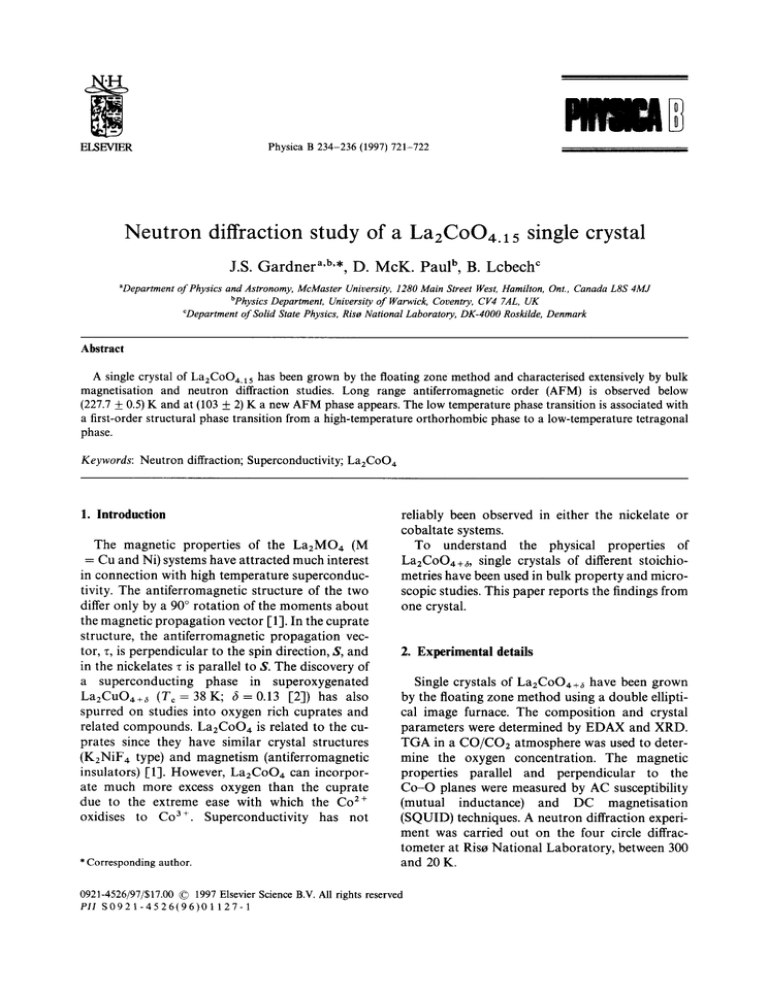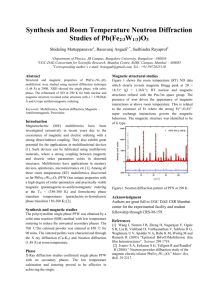
ELSEVIER
Physica B 234-236 (1997) 721-722
Neutron diffraction study of a La2C004.15 single crystal
J.S. G a r d n e r a'b'*, D . M c K . P a u l b, B. L c b e c h ~
aDepartment of Physics and Astronomy, McMaster University, 1280 Main Street West, Hamilton, Ont., Canada L8S 4MJ
bPhysics Department, University of Warwick, Coventry, CV4 7AL, UK
CDepartment of Solid State Physics, Riso National Laboratory, DK-4000 Roskilde, Denmark
Abstract
A single crystal of La2CoO4.15 has been grown by the floating zone method and characterised extensively by bulk
magnetisation and neutron diffraction studies. Long range antiferromagnetic order (AFM) is observed below
(227.7 + 0.5) K and at (103 _ 2) K a new AFM phase appears. The low temperature phase transition is associated with
a first-order structural phase transition from a high-temperature orthorhombic phase to a low-temperature tetragonal
phase.
Keywords: Neutron diffraction; Superconductivity; La2CoO 4
1. Introduction
The magnetic properties of the La2MO4 (M
= Cu and Ni) systems have attracted much interest
in connection with high temperature superconductivity. The antiferromagnetic structure of the two
differ only by a 90 ° rotation of the moments about
the magnetic propagation vector [1]. In the cuprate
structure, the antiferromagnetic propagation vector, z, is perpendicular to the spin direction, S, and
in the nickelates z is parallel to S. The discovery of
a superconducting phase in superoxygenated
La2CuO4+~ (To = 38 K; 6 = 0.13 [2]) has also
spurred on studies into oxygen rich cuprates and
related compounds. LazCoO4 is related to the cuprates since they have similar crystal structures
(K2NiF4 type) and magnetism (antiferromagnetic
insulators) [1]. However, La2CoO4 can incorporate much more excess oxygen than the cuprate
due to the extreme ease with which the Co 2+
oxidises to Co a+. Superconductivity has not
* Corresponding author.
reliably been observed in either the nickelate or
cobaltate systems.
To understand the physical properties of
La2C004+6, single crystals of different stoichiometrics have been used in bulk property and microscopic studies. This paper reports the findings from
one crystal.
2. Experimental details
Single crystals of La2CoO4+~ have been grown
by the floating zone method using a double elliptical image furnace. The composition and crystal
parameters were determined by EDAX and XRD.
TGA in a CO/CO2 atmosphere was used to determine the oxygen concentration. The magnetic
properties parallel and perpendicular to the
C o - O planes were measured by AC susceptibility
(mutual inductance) and DC magnetisation
(SQUID) techniques. A neutron diffraction experiment was carried out on the four circle diffractometer at Riso National Laboratory, between 300
and 20 K.
0921-4526/97/$17.00 © 1997 ElsevierScienceB.V. All rights reserved
PII S092 1-4526(96)0 1 127- 1
722
J.S. Gardner et al. / Physica B 234-236 (1997) 721-722
~ ' 3000
o~~
I
"~ 2500
I
i
I
~"
I
1500
u
'
o~
0 n
u
n
O0
0 O0000<~D(~
O
2000
O
O
e,I 1500
%
1ooo
"~
.~
•
0
1000
0
•
O •
OO
oOqlllllll~l~
.
•
,-"
oo
500
'°
O
O
500
O
I
o
0
50
100
150
200
250
300
Temperature (K)
Fig. 1. The temperature dependence of the magnetic (1 00)
Bragg peak. The solid and open symbols represent warming and
cooling respectively. The error bars are no bigger than the size of
the symbols.
~
o
0
I
50
I
100
I
150
I
200
I
250
300
Temperature (K)
Fig. 2. The variation in intensity with temperature of the magnetic (0 1 1) Bragg Peak. The solid and open symbols represent
wanning and cooling respectively. The two magnetic transitions
are clearly observed. The error bars are no bigger than the size of
the symbols.
3. Results and conclusions
A 0.08 c m 3 single crystal of L a 2 C o O 4 . 1 5 (space
group Cmca at room temperature) was used in the
magnetic and neutron diffraction study in order to
determine its magnetic properties. Magnetisation
measurements (both AC and DC techniques) with
the applied field perpendicular to the Co-O plane
results in one peak at the N6el temperature,
TN = (227.7 + 0.5)K. A second magnetic transitions at T2 = (103 _ 2) K is only observed when
the applied field is in the planes.
Neutron diffraction results showed the crystal to
be twinned in the CoO2 planes and at 103 K an
orthorhombic to tetragonal phase transition occurs
with decreasing temperature (cf La2_xBaxCuO4).
From 103 to 230 K the magnetic moments align
parallel to z 1-1 00] (nickelate-type) and below
103 K the spins rotate within the plane, S =
I-0 0 1], (cuprate type).
Fig. 1 shows the temperature dependence of the
magnetic (1 0 0) Bragg peak. It is clear from the
hysteresis that the transition at 103 K is first order.
The doubling of the intensity at 103 K is an indication that the twinned a and c axis become equal in
length at the structural transition. The temperature
dependence of the (0 0 1) peak is the same as the
(1 00) within experimental error. Fig. 2 shows
the temperature dependence of the (0 1 1) magnetic
Bragg peak, again hysteresis clearly signals the
first-order transition at T 2. The drop in the intensity at 103 K is associated with the 90 ° rotation of
the moment.
Several distinct differences can be seen between
our results and those reported by Yamada et al.
from a La2CoO4 single crystal. First, we observe
the N~el temperature at (227.7 + 0.5) K rather than
275K. Secondly, the first-order transition at
(103 + 2)K was observed at 135 K by Yamada
et al. and finally, we observe the magnetic Bragg
reflection (1 0 0) at all temperatures below the N6el
temperature, unlike Yamada et al. who only observed it below 135 K.
Acknowledgements
The work that was carried out at Riso was financially supported through the European Community Large Installation Plan.
References
r l ] K. Yamada, M. Matsuda, Y. Endoh, B. Keimer, R.J. Bir
grneau, S. Onodera, J. Mizusaki, T. Matsuura and
G. Shirane, Phys Rev. B 39 (1989) 2336.
1-2] P.M. Grant, S.S.P. Parkin, V.Y. Lee, E.M. Engler, M.L.
Ramirez, J.E. Vazquez, G. Lim, R.D. Jacowitz and R.L.
Greene, Phys Rev. Lett., 58 (1987) 2482.




